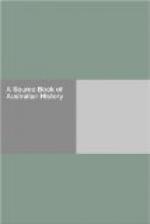Some idea of the difficulty to be faced may be gathered when it is remembered that every round of ammunition, all water, and all supplies had to be landed on a narrow beach and then carried up pathless hills, valleys, and bluffs, several hundred feet high, to the firing line. The whole of this mass of troops, concentrated on a very small area, and unable to reply, were exposed to a relentless and incessant shrapnel fire, which swept every yard of the ground, although, fortunately, a great deal of it was badly aimed or burst too high. The reserves were engaged in road-making and carrying supplies to the crest, and in answering the calls for more ammunition.
A serious problem was getting away the wounded from the shore, where it was impossible to keep them. All those who were unable to hobble to the beach had to be carried down to the hills on stretchers, then hastily dressed and carried to the boats. The boat and beach parties never stopped working throughout the entire day and night.
The courage displayed by these wounded Australians will never be forgotten. Hastily dressed and placed in trawlers, lighters, and ships’ boats they were towed to the ships.... I have, in fact, never seen the like of those wounded Australians in war before, for as they were towed amongst the ships, whilst accommodation was being found for them, although many were shot to bits, and without hope of recovery, their cheers resounded through the night, and you could just see, amidst a mass of suffering humanity, arms being waved in greeting to the crews of the warships. They were happy because they had been tried for the first time in the war and had not been found wanting. They had been told to occupy the heights and hold on, and this they had done for fifteen mortal hours, under an incessant shell fire, without the moral and material support of a single gun ashore, and subjected the whole time to the violent counter-attacks of a brave enemy, led by skilled leaders, whilst his snipers, hidden in caves and thickets and amongst the dense scrub, made a deliberate practice of picking off every officer who endeavoured to give a word of command or lead his men forward.
No finer feat of arms has been performed during the war than this sudden landing in the dark, the storming of the heights, and above all, the holding on to the position thus won whilst reinforcements were being poured from the transports. These raw Colonial troops in those desperate hours proved themselves worthy to fight side by side with the heroes of Mons and the Aisne, Ypres, and Neuve Chapelle.
WHAT ANZAC MEANS
By Senator Pearce (Minister of State for Defence)
+Source.+—The Melbourne Argus, 25 April 1916
In an army a knowledge of its past achievements is a mighty factor in its future success. Before this war Australia had practically no army traditions, and it is to the meaning of the Gallipoli campaign in this connection that I would direct attention to-day, twelve months after the historic landing.




